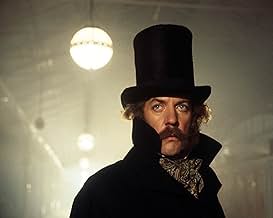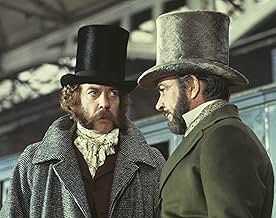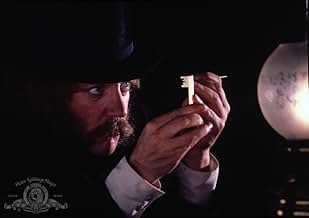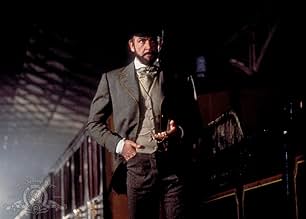VALUTAZIONE IMDb
6,9/10
21.008
LA TUA VALUTAZIONE
Inghilterra, 1850. Un maestro criminale mira a derubare un treno di una grossa somma d'oro. La sicurezza è incredibilmente stretta e il compito sembra impossibile.Inghilterra, 1850. Un maestro criminale mira a derubare un treno di una grossa somma d'oro. La sicurezza è incredibilmente stretta e il compito sembra impossibile.Inghilterra, 1850. Un maestro criminale mira a derubare un treno di una grossa somma d'oro. La sicurezza è incredibilmente stretta e il compito sembra impossibile.
- Premi
- 1 vittoria e 1 candidatura in totale
Brian de Salvo
- John - Trent's Butler
- (as Brian De Salvo)
André Morell
- Judge
- (as Andre Morell)
Recensioni in evidenza
The year is 1855. The place is England. A man going by the name of Edward Pierce (Sean Connery) has his eyes on a near impossible heist. He wants to steal the Crimean gold that goes by railway from one part of England to another. Besides the fact it's guarded at the time of transit, the safe requires four separate keys that are in three separate locations. Oh yeah, and no one has ever robbed a moving locomotive before. I suppose he could Butch-Cassidy-and-the-Sundance-Kid it and force the train to stop, then blow open the safe. But this is England and no such brutish tactics will be used. This will take stealth, guile, and intelligence. In other words, it was a sophisticated operation.
This was a superb heist movie. It was clever, it was cohesive, and it was funny. I liked the pairing of Connery and Donald Sutherland. Heist movies always have to be clever and cutting edge because the mark is always super-secure and nearly impossible to breach. What sets one heist movie apart from the other is the story within and the characters. This story was straight forward and simple. There were no red herrings, no sappy side stories, and no deux ex-machinas. And the characters were very enjoyable.
This Michael Crichton film was simply excellent.
This was a superb heist movie. It was clever, it was cohesive, and it was funny. I liked the pairing of Connery and Donald Sutherland. Heist movies always have to be clever and cutting edge because the mark is always super-secure and nearly impossible to breach. What sets one heist movie apart from the other is the story within and the characters. This story was straight forward and simple. There were no red herrings, no sappy side stories, and no deux ex-machinas. And the characters were very enjoyable.
This Michael Crichton film was simply excellent.
The Great Train Robbery follows the standard heist movie blueprint. The team gets assembled to pull off an impossible job, they do all of the complicated prep work, then there is a last minute complication that makes it much more difficult than they expected. What stands out here is the setting, Victorian England, and the much smaller crew of thieves than usual. Most heist movies have a huge crew of 10+ characters that each need to have their characters explored. Here there is just the mastermind (Sean Connery), the pickpocket (Donald Sutherland), the girl (Lesley-Anne Downs), and the greaseman (Wayne Sleep). There are a few others, but their characters are so minor that they do not even get names. Rather than get sidetracked covering side characters, there is a strong focus on moving the plot forward that makes the entire movie more interesting.
What also stands out is the impressive stunts that were done mostly without stuntmen. Wayne Sleep really scales a wall and Sean Connery really walks across the top of a moving train. In today's CGI heavy film industry, it is refreshing to see an older movie that stays simpler with its big stunts, but they feel much realer, because they are. A lot of the movie relies on Sean Connery's natural charisma, which is the secret to a good heist movie, and Connery holds up very well compared to Clooney and Sinatra in the Ocean's movies and Newman and Redford in The Sting.
What also stands out is the impressive stunts that were done mostly without stuntmen. Wayne Sleep really scales a wall and Sean Connery really walks across the top of a moving train. In today's CGI heavy film industry, it is refreshing to see an older movie that stays simpler with its big stunts, but they feel much realer, because they are. A lot of the movie relies on Sean Connery's natural charisma, which is the secret to a good heist movie, and Connery holds up very well compared to Clooney and Sinatra in the Ocean's movies and Newman and Redford in The Sting.
I was very surprised when I saw that "The First Great Train Robbery" was written and directed by Michael Crichton. This is because Crichton is normally associated with sci-fi and fantasy, such as "The Andromeda Strain", "Coma", "Westworld" and "Jurassic Park". But apparently in 1975, Crichton wrote a book about this actual robbery in 1855...though the film ended up being highly fictionalized, particularly the ending.
The first two-thirds of the film is very slow and meticulous. I didn't mind this too much, though I am sure this will lose a lot of viewers. My suggestion is bear with it. First, it is well crafted. Second, the look of VIctorian London is wonderful....so take time to enjoy what you are seeing. The final portion is much more exciting and concerns the robbery itself. It's amazing to see Sean Connery doing his own stunts* and the footage is incredible...and it must have been incredible to see on the big screen.
Overall, a slow and deliberate movie that is great provided you don't mind the pace or that too much of the story is fictionalized in order to make the story more cinematic. The ending, in particular, is pure fiction and the real case, though interesting, is much different.
I do have two further comments. First, the sound on this DVD was abominable...with music that is so much louder than the dialog. You really do need the closed captions in order to watch the film....it's that bad. Second, one mistake I noticed is that the 'gold' in the film was ridiculously lightweight...and seeing Connery and Sutherland EASILY tossing the bags of gold off the train (as if they were filled with newspapers or scones) was silly.
*I know that they touted how Sean Connery did the insane stunt of climbing across the moving train and he clearly did. But in a few scenes, despite the hype, I do strongly suspect that a stuntman was occasionally used...such as when Connery's character is hanging off the sides of the moving train.
The first two-thirds of the film is very slow and meticulous. I didn't mind this too much, though I am sure this will lose a lot of viewers. My suggestion is bear with it. First, it is well crafted. Second, the look of VIctorian London is wonderful....so take time to enjoy what you are seeing. The final portion is much more exciting and concerns the robbery itself. It's amazing to see Sean Connery doing his own stunts* and the footage is incredible...and it must have been incredible to see on the big screen.
Overall, a slow and deliberate movie that is great provided you don't mind the pace or that too much of the story is fictionalized in order to make the story more cinematic. The ending, in particular, is pure fiction and the real case, though interesting, is much different.
I do have two further comments. First, the sound on this DVD was abominable...with music that is so much louder than the dialog. You really do need the closed captions in order to watch the film....it's that bad. Second, one mistake I noticed is that the 'gold' in the film was ridiculously lightweight...and seeing Connery and Sutherland EASILY tossing the bags of gold off the train (as if they were filled with newspapers or scones) was silly.
*I know that they touted how Sean Connery did the insane stunt of climbing across the moving train and he clearly did. But in a few scenes, despite the hype, I do strongly suspect that a stuntman was occasionally used...such as when Connery's character is hanging off the sides of the moving train.
Writing and directing The Great Train Robbery, Michael Crichton took much license with the facts of the story's basis, mostly to incorporate a tone of sardonic humor and mean-spirited mustachioed grinning. Sir Sean Connery has always been a great light comedian, having played Bond as a discreetly comic character. That's probably why Lazenby and Moore never totally matched him: They played 007 too orthodox. In Connery's charismatic oeuvre, master safecracker Edward Pierce is no exception.
The inimitable Donald Sutherland, playing a Victorian pickpocket and con man, is somewhat miscast as Connery's partner. He is not convincingly English, to my surprise frankly, though he does bring a new characteristic or two to virtually each film he's in, and here he's not just Connery's cohort but his foil. Leslie Ann Down plays Connery's moll and co-conspirator, and she appears to have been preordained to wear Victorian undergarments.
The plot for the heist is rather upfront: The train's safe, containing the gold, is protected with four keys, each in different hands. The challenge is to divide these holders from their keys, if possible in scenarios that serious, by-the-book Victorian gentlemen would be opposed to explaining to the police, so one aged banker is shadowed at a dogfight and another is intercepted in a brothel. There's also a Stopwatch Sequence for caper enthusiasts like me: Connery and Sutherland undergo numerous trials before endeavoring to burglarize the railway company office, and we get a gracefully stage-managed robbery effort with all the timeless taps like the guard reappearing a nanosecond after the critical moment and such.
One of the foremost amusements of this drum-tight caper is the way it's determinedly in the Victorian era. The costumes and the art direction are sincere, Crichton infuses his dialogue with undoubtedly genuine Victorian gangland wording, and, for the climactic train heist, they even constructed a whole operational train. Other gratifications: The nefarious deception used to smuggle Connery into the protected car with the gold; the chase sequence atop the train; and, certainly, the loin-scorchingly superb presence of Down, who is wryly funny in her own right.
An ornately thorough and exciting caper that parades historical accuracy in support of the tempting charisma of gentleman scoundrels up to no good. Connery and Sutherland are unscrupulous to their foundations but full of audacity and shrewdness. We're supportive of them all the way, with their dashing top hats, rustling coat-tails and panorama of facial hair.
There's a patent two-act structure to the proficient script. Crichton has a scientist's sensitivity to exactitude. First the crack team toil through the preparation phases, as they progressively appropriate indentations of the four keys necessary to unlock the safe, resulting in the heist itself on a train tearing through the British scenery. In the course of this era of steam power, it appeared a hopeless scheme. Meek, perhaps, by the wicked tempo of modern action sequences, Crichton nevertheless infuses a rousing realism with Connery mannishly performing his own stunts as he traverses the rooftop through clouds of grimy smoke, for the golden fleece.
All around, Crichton absorbs the tissue and texture of whimsical Victoriana from the bitter brick walls of the prison for Wayne Sleep's lithe prison escape to the plush, glossy furnishings of the brothel where the sexy Down slips a key from Alan Webb's frenziedly horny bank manager. But naturalism is not the approach, Crichton is after a giddy attribute like it's being told as a tall story in a pub sopping in overstatement and heightened deceit to whitewash impractical snags.
The inimitable Donald Sutherland, playing a Victorian pickpocket and con man, is somewhat miscast as Connery's partner. He is not convincingly English, to my surprise frankly, though he does bring a new characteristic or two to virtually each film he's in, and here he's not just Connery's cohort but his foil. Leslie Ann Down plays Connery's moll and co-conspirator, and she appears to have been preordained to wear Victorian undergarments.
The plot for the heist is rather upfront: The train's safe, containing the gold, is protected with four keys, each in different hands. The challenge is to divide these holders from their keys, if possible in scenarios that serious, by-the-book Victorian gentlemen would be opposed to explaining to the police, so one aged banker is shadowed at a dogfight and another is intercepted in a brothel. There's also a Stopwatch Sequence for caper enthusiasts like me: Connery and Sutherland undergo numerous trials before endeavoring to burglarize the railway company office, and we get a gracefully stage-managed robbery effort with all the timeless taps like the guard reappearing a nanosecond after the critical moment and such.
One of the foremost amusements of this drum-tight caper is the way it's determinedly in the Victorian era. The costumes and the art direction are sincere, Crichton infuses his dialogue with undoubtedly genuine Victorian gangland wording, and, for the climactic train heist, they even constructed a whole operational train. Other gratifications: The nefarious deception used to smuggle Connery into the protected car with the gold; the chase sequence atop the train; and, certainly, the loin-scorchingly superb presence of Down, who is wryly funny in her own right.
An ornately thorough and exciting caper that parades historical accuracy in support of the tempting charisma of gentleman scoundrels up to no good. Connery and Sutherland are unscrupulous to their foundations but full of audacity and shrewdness. We're supportive of them all the way, with their dashing top hats, rustling coat-tails and panorama of facial hair.
There's a patent two-act structure to the proficient script. Crichton has a scientist's sensitivity to exactitude. First the crack team toil through the preparation phases, as they progressively appropriate indentations of the four keys necessary to unlock the safe, resulting in the heist itself on a train tearing through the British scenery. In the course of this era of steam power, it appeared a hopeless scheme. Meek, perhaps, by the wicked tempo of modern action sequences, Crichton nevertheless infuses a rousing realism with Connery mannishly performing his own stunts as he traverses the rooftop through clouds of grimy smoke, for the golden fleece.
All around, Crichton absorbs the tissue and texture of whimsical Victoriana from the bitter brick walls of the prison for Wayne Sleep's lithe prison escape to the plush, glossy furnishings of the brothel where the sexy Down slips a key from Alan Webb's frenziedly horny bank manager. But naturalism is not the approach, Crichton is after a giddy attribute like it's being told as a tall story in a pub sopping in overstatement and heightened deceit to whitewash impractical snags.
The First Great Train Robbery is directed by Michael Crichton who also writes the screenplay. It stars Sean Connery, Donald Sutherland, Lesley-Anne Down, Wayne Sleep, Robert Lang, Alan Webb and Andre Morell. Music is scored by Jerry Goldsmith and cinematography by Geoffrey Unsworth. The story is loosely based on the real Great Gold Robbery of 1855, where a rogue criminal named William Pierce and his cohorts executed the theft of £12,000 in gold from a speeding train on route to aid the British Army during the Crimean War.
A delightful period caper picture that's high on production value and fun characterisations. Split into two halves, Crichton's movie makes light of the actual crime to portray Connery and co as lovable rogues, thus hooking the viewer in to actually root for them to pull off the intricate crime. First half (well it's more two thirds of the film to be exact) details how the robbers obtained the four keys needed to get into the safe. Harder than it sounds since they are in different locations to one and other and guarded over by different officials. Naturally there are scrapes, skirmishes and obstacles to overcome during this complex operation, and no short amount of humour and tension either. Then it's on to the actual crime, which buzzes ferociously with derring do and ingenious cheek! It may have been loaded with chitter chatter and much bluffing of the way leading up to it, but the pay off is excellent and not without genuine excitement as Connery's (doing his own stunt work) Pierce and Sutherland's safe cracking Agar pull off the seemingly impossible.
Benefiting the film greatly is Crichton's attention to detail, where he thrives on the Victorian England setting. From the streets, the costumes, the dialogue and mannerisms of the characters, they all fit nicely within the narrative. Helps, too, that the cast are playing it with tongue in cheek, Connery and Sutherland are revelling in playing roguish dandies, splendidly attired facially with quality face fuzz and Down raises the temperature of Connery and male audience members alike. Probably her best ever performance, Crichton writes a good role for Down that sees her not only as a sexy head turner (it's unlikely that Victorian underwear has ever looked this sexy before in film), but also as an observant member of the gang; one who isn't too shabby on the disguise front either. Dancer Wayne Sleep is nicely cast as a fleet footed housebreaker, while Lang, Webb, Morell and Michael Elphick pitch their respective performances just right. Goldsmith's score is energetic and Unsworth's (his last film as he sadly passed away shortly after shooting it) photography is a lesson in quality without trickery.
Fanciful and tame if compared to the big budgeted actioners of today, The First Great Train Robbery none the less is testament that simplicity of plot and a keenness to entertain is sometimes all you need. 8/10
A delightful period caper picture that's high on production value and fun characterisations. Split into two halves, Crichton's movie makes light of the actual crime to portray Connery and co as lovable rogues, thus hooking the viewer in to actually root for them to pull off the intricate crime. First half (well it's more two thirds of the film to be exact) details how the robbers obtained the four keys needed to get into the safe. Harder than it sounds since they are in different locations to one and other and guarded over by different officials. Naturally there are scrapes, skirmishes and obstacles to overcome during this complex operation, and no short amount of humour and tension either. Then it's on to the actual crime, which buzzes ferociously with derring do and ingenious cheek! It may have been loaded with chitter chatter and much bluffing of the way leading up to it, but the pay off is excellent and not without genuine excitement as Connery's (doing his own stunt work) Pierce and Sutherland's safe cracking Agar pull off the seemingly impossible.
Benefiting the film greatly is Crichton's attention to detail, where he thrives on the Victorian England setting. From the streets, the costumes, the dialogue and mannerisms of the characters, they all fit nicely within the narrative. Helps, too, that the cast are playing it with tongue in cheek, Connery and Sutherland are revelling in playing roguish dandies, splendidly attired facially with quality face fuzz and Down raises the temperature of Connery and male audience members alike. Probably her best ever performance, Crichton writes a good role for Down that sees her not only as a sexy head turner (it's unlikely that Victorian underwear has ever looked this sexy before in film), but also as an observant member of the gang; one who isn't too shabby on the disguise front either. Dancer Wayne Sleep is nicely cast as a fleet footed housebreaker, while Lang, Webb, Morell and Michael Elphick pitch their respective performances just right. Goldsmith's score is energetic and Unsworth's (his last film as he sadly passed away shortly after shooting it) photography is a lesson in quality without trickery.
Fanciful and tame if compared to the big budgeted actioners of today, The First Great Train Robbery none the less is testament that simplicity of plot and a keenness to entertain is sometimes all you need. 8/10
Lo sapevi?
- QuizWriter and director Michael Crichton based his book and movie only loosely on the actual crime committed in 1855. In real-life, there were four criminals: Pierce, Agar, the railway guard Burgess and a railway clerk named Tester. All four keys were kept on railway premises, two in London, and two in Folkestone. They were stolen temporarily by Tester and Pierce, respectively, so that Agar could duplicate them, but it turned out that the Folkestone keys were not being used anyway. The guard's van was not locked from the outside; Pierce and Agar were let in by Burgess and a share of the loot was handed out to Tester at stations. None of the criminals were spotted at once; it was several months before the railway conceded that the crime must have occurred on the train. The details came to light after Agar had been convicted in an unrelated crime and his accomplices decided to steal his share instead of using it, as he had asked, to provide his mistress an income. She got word to him and he turned Queen's Evidence against the others and told all. At no point in the case did anyone escape custody.
- BlooperIf the gold shipment was solely to pay British soldiers in Crimea, as asserted, it would have been in the form of barrels of gold coins, not gold bars as shown.
- Citazioni
Judge: [Judgementally] Now, on the matter of motive, we ask you: Why did you conceive, plan and execute this dastardly and scandalous crime?
Edward Pierce: I wanted the money.
[the court spectators roar with laughter]
- Curiosità sui creditiCóras Iompair Éireann is misspelled in the end titles with an accent over the 'C' instead of the 'o'.
- Versioni alternativeUnder the terms of the Cinematograph Films (Animals) Act 1937 all UK versions of the film are cut by 32 secs with edits to a scene where a dog hunts and kills rats in a show arena ('ratting').
- Colonne sonoreI Dreamt I Dwelt in Marble Halls
(uncredited)
Music by Michael William Balfe
Lyrics by Alfred Bunn (1843)
Heard on violin offstage in bordello
I più visti
Accedi per valutare e creare un elenco di titoli salvati per ottenere consigli personalizzati
Dettagli
- Data di uscita
- Paese di origine
- Lingue
- Celebre anche come
- 1855 - La grande rapina al treno
- Luoghi delle riprese
- Cork Kent station, Glanmire Road, Cork, County Cork, Irlanda(Brighton station)
- Aziende produttrici
- Vedi altri crediti dell’azienda su IMDbPro
Botteghino
- Budget
- 6.000.000 USD (previsto)
- Lordo Stati Uniti e Canada
- 13.027.857 USD
- Fine settimana di apertura Stati Uniti e Canada
- 391.942 USD
- 4 feb 1979
- Lordo in tutto il mondo
- 13.027.857 USD
- Tempo di esecuzione
- 1h 50min(110 min)
- Colore
- Proporzioni
- 1.85 : 1
Contribuisci a questa pagina
Suggerisci una modifica o aggiungi i contenuti mancanti






















